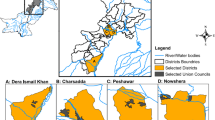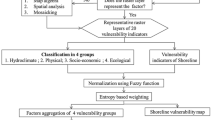Abstract
The decision making process in flood mitigation typically involves a number of factors reflecting flood severity, flood vulnerability and the cost of the mitigation measures, which implies that the decision framework needs to combine both social–economic parameters and flood extent prediction analysis. A socio-economic vulnerability index (SEVI) is developed here to represent social–economic factors and its use demonstrated within a multi-criteria decision analysis (MCDA) for assessing flood levee options for a central basin of Jakarta, Indonesia. The variables defining the SEVI are selected based on available national social–economic data reported for Indonesia with overlapping information removed using Pearson’s correlation analysis. Two different methods are used to further scale the SEVI which is developed along administrative boundaries into a Net SEVI which is dependent on the predicted flood hazard as resulting from the levee plan options while capturing uncertainty in the rainfall forecasting. The MCDA technique adopted uses criteria of Net SEVI, annual expected loss, graduality and levee construction cost for analyzing six different levee plans and with uncertainty in the rainfall incorporated. The Net SEVI thus specifically reflects the social–economic impact on the flood-affected population, and this approach thereby provides a higher degree of granularity in the flood mitigation decision process. The MCDA decision framework developed is general in that the Net SEVI can be applied for consideration of other flood mitigation strategies. Here, it is shown that the inclusion of the Net SEVI criteria changes the best choice levee plan decision to a higher protection level for the basin considered.
Similar content being viewed by others
References
Apel H, Merz B, Thieken AH (2008) Quantification of uncertainties in flood risk assessments. Int J River Basin Manag 6:149–162. doi:10.1080/15715124.2008.9635344
Balica S, Wright NG (2010) Reducing the complexity of the flood vulnerability index. Environ Hazards 9:321–339. doi:10.3763/ehaz.2010.0043
Balica SF, Douben N, Wright NG (2009) Flood vulnerability indices at varying spatial scales. Water Sci Technol 60:2571–2580. doi:10.2166/wst.2009.183
Birkmann J (2007) Papers: risk and vulnerability indicators at different scales: applicability, usefulness and policy implications. Environ Hazards 7:20–31. doi:10.1016/j.envhaz.2007.04.002
Birkmann J (2013) Measuring vulnerability to promote disaster-resilient societies and to enhance adaption: discussion of conceptual frameworks and definitions. In: Birkmann J (ed) Measuring vulnerability to natural hazards: towards disaster resilient societies. United Nations University Press, New York, pp 9–54
Boerema J (1925) Uitbreiding van regenbuien te Batavia = (Extension of rainshowers at Batavia) vol 15. Magnetisch en Meteorologisch Observatorium Verhandelingen. Albrecht & Co
BPS (2005–2015(a)) Jakarta in Figures. Badan Pusat Satistik (BPS) Indonesia, Jakarta, Indonesia
BPS (2015(b)) Statistical Yearbook of Indonesia. Badan Pusat Satistik (BPS) Indonesia, Jakarta, Indonesia
Cardona OD (2006) A system of indicators for disaster risk management in the America. In: Birkmann J (ed) Measuring vulnerability to natural hazards: towards disaster resilient societies, 1st edn. United Nations University Press, New York, pp 189–209
Chen J, Brissette FP, Leconte R (2011) Uncertainty of downscaling method in quantifying the impact of climate change on hydrology. J Hydrol 401:190–202. doi:10.1016/j.jhydrol.2011.02.020
Cho HN, Frangopol DM, Ang AHS Life-Cycle Cost and Performance of Civil Infrastructure Systems. In: Hyo-Nam Cho, Frangopol DM, Ang AH-S (eds) The fifth international workshop on life-cycle cost analysis and design of civil infrastructure systems, Seoul, Korea, 2007. Taylor and Francis, pp 85–92
Connor RF, Hiroki K (2005) Development of a method for assessing flood vulnerability. Water Sci Technol 51:61–67
Daksiya V, Su HT, Lo EY, Cheung SH (2015) Analyzing uncertain rainfall in flood mitigation using MCDA. In: Paper presented at the symposium on reliability of engineering systems, Taipei, Taiwan, 21–24 October
De Bruijn KM (2005) Resilience and flood risk management a systems approach applied to lowland rivers. Doctoral thesis, Delft University of Technology
Duan H-F, Li F, Tao T (2016) Multi-objective optimal design of detention tanks in the urban stormwater drainage system: uncertainty and sensitivity analysis. Water Resour Manage 30:2213–2226. doi:10.1007/s11269-016-1282-1
Faisal IM, Kabir MR, Nishat A (1999) Non-structural flood mitigation measures for Dhaka City. Urban Water 1:145–153
Georgopoulou E, Sarafidis Y, Diakoulaki D (1998) Design and implementation of a group DSS for sustaining renewable energies exploitation. Eur J Oper Res 483–500
IPCC (2007) Intergovernmental Panel on Climate Change 2007: synthesis report. http://www.ipcc.ch/ipccreports/ar4-syr.html
Jongman B, Ward PJ, Aerts JCJH (2012) Global exposure to river and coastal flooding: long term trends and changes. Glob Environ Chang 22:823–835. doi:10.1016/j.gloenvcha.2012.07.004
Li F, Duan H-F, Yan H, Tao T (2015) Multi-objective optimal design of detention tanks in the urban stormwater drainage system: framework development and case study. Water Resour Manage 29:2125–2137. doi:10.1007/s11269-015-0931-0
Lo EY, Chen CN (2013) Flood assessment study for Jakarta. In: Paper presented at the proceedings of the 35th International Association of Hydro-Environment Engineering and Research (IAHR) World Congress, Chengdu, China, 8–13 September
Maskey S, Guinot V, Price RK (2004) Treatment of precipitation uncertainty in rainfall-runoff modelling: a fuzzy set approach. Adv Water Resour 27:889–898. doi:10.1016/j.advwatres.2004.07.001
Overeem A, Buishand A, Holleman I (2008) Rainfall depth-duration-frequency curves and their uncertainties. J Hydrol 348:124–134. doi:10.1016/i.jhydrol.2007.09.044
Partner For Waters (2007) Hydrology and sea water level: dutch assistance with non-structural measures Jakarta Flood Management. Jakarta Flood Team, NEDECO, Jakarta, Indonesia
Prudhomme C, Jakob D, Svensson C (2003) Uncertainty and climate change impact on the flood regime of small UK catchments. J Hydrol 277:1–23. doi:10.1016/S0022-1694(03)00065-9
Su HT, Tung YK (2014) Multi-criteria decision making under uncertainty for flood mitigation. Stoch Environ Res Risk Assess 28:1657–1670. doi:10.1007/s00477-013-0818-7
Thampapillai DJ, Musgrave WF (1985) Flood damage mitigation: a review of structural and nonstructural measures and alternative decision frameworks. Water Resour Res 21:411–424. doi:10.1029/WR021i004p00411
Vojinović Z, Abbott MB (2012) Flood risk and social justice: from quantitative to qualitative flood risk assessment and mitigation. In: Urban hydroinformatics series, 1st edn. IWA, London
Yu W, Nakakita E, Kim S, Yamaguchi K (2016) Impact assessment of uncertainty propagation of ensemble NWP rainfall to flood forecasting with catchment scale. Adv Meteorol 2016:17. doi:10.1155/2016/1384302
Author information
Authors and Affiliations
Corresponding author
Rights and permissions
About this article
Cite this article
Daksiya, V., Su, H.T., Chang, Y.H. et al. Incorporating socio-economic effects and uncertain rainfall in flood mitigation decision using MCDA. Nat Hazards 87, 515–531 (2017). https://doi.org/10.1007/s11069-017-2774-x
Received:
Accepted:
Published:
Issue Date:
DOI: https://doi.org/10.1007/s11069-017-2774-x









